


2. HISTORICAL OVERVIEW
2.1. Inner Ring Structures
Ring-like structures in the luminosity distribution of galaxies have
been known since photography was applied to nebular research in the
late 19th and early 20th centuries. The discovery of rings parallels
the discovery of spiral structure in the 19th century, because some
ring and pseudoring structures in several nearby galaxies were bright
enough to have been seen visually with the 1.8-m speculum reflector of
Birr Castle Observatory and other telescopes (see
Figure 2). The accuracy of these early
observations was
confirmed through photographic observations with the Lick Crossley
reflector in 1898-1900 by
Keeler (1908).
However, it was
Curtis (1918)
who first brought attention to a special class of spiral ``nebulae''
where a ring or pseudoring and a bar were characteristic parts of the
structure. Four examples, NGC 1300,
NGC 1530,
NGC 3351, and NGC 5921
were illustrated in his classic paper, a compendium of descriptions of
762 ``nebulae and clusters'', of which 513 were spirals. He called the
ones with a ``band of matter extending diametrically across the inner
parts'' and ``whorls'' forming a ``near perfect ring'', ``  -type''
spirals, ``for lack of a better name.'' The objects Curtis first
described are now recognized as ``barred spirals'', a term coined by
Hubble (1926),
and the near perfect ring as an ``inner ring.'' Although
Curtis referred to them as
-type''
spirals, ``for lack of a better name.'' The objects Curtis first
described are now recognized as ``barred spirals'', a term coined by
Hubble (1926),
and the near perfect ring as an ``inner ring.'' Although
Curtis referred to them as  -type, a term such as
-type, a term such as  -type is
actually more appropriate since the bar never exceeds the extent of the
ring (see Figure 3).
(1)
Hubble (1926)
would have used
the term
-type is
actually more appropriate since the bar never exceeds the extent of the
ring (see Figure 3).
(1)
Hubble (1926)
would have used
the term  -type in
his classification system, but Greek letters were inconvenient for
catalogs in his day, so he chose the term ``barred spirals'' instead.
Typically, the spiral structure of such a galaxy emerges from the inner
ring, but
Reynolds (1921)
discovered two examples where only the
-type in
his classification system, but Greek letters were inconvenient for
catalogs in his day, so he chose the term ``barred spirals'' instead.
Typically, the spiral structure of such a galaxy emerges from the inner
ring, but
Reynolds (1921)
discovered two examples where only the
 shape was visible on his
plates. Later, Hubble
(1926,
1936)
observed that the appearance of the
ring in the
shape was visible on his
plates. Later, Hubble
(1926,
1936)
observed that the appearance of the
ring in the  -types was
manifested by a tight spiral structure, which became more open as the
spiral sequence progressed. In the
-types was
manifested by a tight spiral structure, which became more open as the
spiral sequence progressed. In the  -type spiral (NGC 1433) illustrated in
Figure 3, the
ring is a tight spiral pattern that closes around the bar ends.
-type spiral (NGC 1433) illustrated in
Figure 3, the
ring is a tight spiral pattern that closes around the bar ends.
Figure 3.
B-band CCD image of NGC 1433, a `` -type spiral'' with a bright inner ring.
-type spiral'' with a bright inner ring.
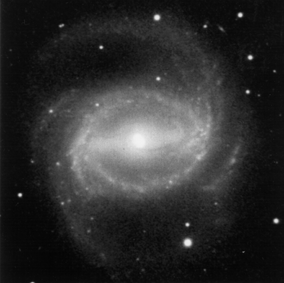
|
The diversity of ringed galaxies became more apparent during later
phases of Hubble's nebular research. In his discussion of Hubble's
revision to the standard classification system,
Sandage (1961)
described in the Hubble Atlas of Galaxies an additional category of
normal spirals where the arms begin tangential to the periphery of an
``internal'' ring. As with the  -type spirals, these rings
appeared to be linked to the spiral pattern in the sense that the rings
become more open towards the later spiral stages (i.e., from Sa to Sc).
Some of the first examples of this kind of ringed spiral were
discovered by
Shapley &
Paraskevopoulos (1940),
who called them
``plate spirals'' because of the image conveyed by a ring which tightly
wraps the nucleus in a face-on view (i.e., the appearance of a central
plate or disk). The original examples of ``plate spirals'' were
NGC 6753 and the close pair NGC 6935 and NGC 6937, the latter now being
known to contain a weak bar. Several of the examples of this kind of
galaxy illustrated in the Hubble Atlas probably also have bars that are
highly foreshortened (e.g. NGC 4274) or which are simply weak. Some
``plate spirals'' such as NGC 6902 (see
Figure 4) appear
perfectly nonbarred in blue light but show weak bars in near infrared
images. Other nonbarred ringed galaxies, such as NGC 4736, have strong
obvious ovals rather than conventional bars. Nevertheless, genuine
examples of nonbarred ringed galaxies do exist (e.g., NGC 7217, see
Figure 5; and NGC 4622, see
Buta et al. 1992
and Section 17.1), although they are less
common than the
-type spirals, these rings
appeared to be linked to the spiral pattern in the sense that the rings
become more open towards the later spiral stages (i.e., from Sa to Sc).
Some of the first examples of this kind of ringed spiral were
discovered by
Shapley &
Paraskevopoulos (1940),
who called them
``plate spirals'' because of the image conveyed by a ring which tightly
wraps the nucleus in a face-on view (i.e., the appearance of a central
plate or disk). The original examples of ``plate spirals'' were
NGC 6753 and the close pair NGC 6935 and NGC 6937, the latter now being
known to contain a weak bar. Several of the examples of this kind of
galaxy illustrated in the Hubble Atlas probably also have bars that are
highly foreshortened (e.g. NGC 4274) or which are simply weak. Some
``plate spirals'' such as NGC 6902 (see
Figure 4) appear
perfectly nonbarred in blue light but show weak bars in near infrared
images. Other nonbarred ringed galaxies, such as NGC 4736, have strong
obvious ovals rather than conventional bars. Nevertheless, genuine
examples of nonbarred ringed galaxies do exist (e.g., NGC 7217, see
Figure 5; and NGC 4622, see
Buta et al. 1992
and Section 17.1), although they are less
common than the  -types (see
Section 9.1).
-types (see
Section 9.1).
Figure 4.
B-band image of NGC 6902, a ``plate spiral'' with a bright inner ring.
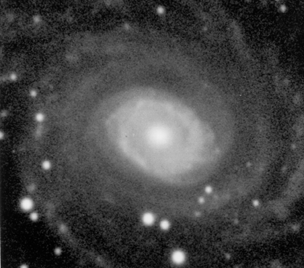
|
Figure 5.
B-band image of NGC 7217, a nonbarred ringed spiral with a bright
ring and a multi-armed spiral pattern breaking from the ring.
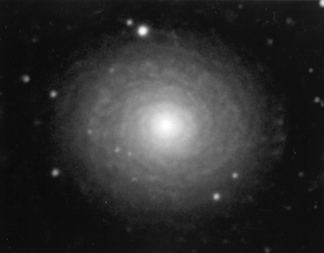
|
In a personal revision of the Hubble-Sandage classification system, de
Vaucouleurs
(1956,
1959a)
considered the presence or absence of a bar as
a ``family'' characteristic and the presence or absence of an inner
ring as a ``variety'' characteristic. The continuous variation of these
characteristics at a given stage (i.e., a galaxy can be
``weakly-barred'' or include a partial, broken ring) led him to
construct a three-dimensional classification volume
(Figure 6), a well-known cross-section of which
(de Vaucouleurs & de
Vaucouleurs 1964)
is shown in Figure 7.
The system is a generalization of a scheme illustrated by Sandage
(1961,
1975),
and in it pure inner rings (r) are simply the endpoint in
a continuum of forms that becomes increasingly less ``ringed'' and more
``spiral'' (s) as one proceeds right to left in the classification
volume. Those galaxies which are intermediate between these extremes
are said to have ``pseudorings'', denoted by the combined symbol (rs).
Figures 8, 9,
10 exhibit CCD images of galaxies
covering the full range of families and varieties.
Figure 7
also illustrates de Vaucouleurs' observations on how the morphology of
the spiral structure emerging from the inner ring depends on family.
In barred (SB) spirals, the spiral structure emerges from the ring as a
global pattern, usually with two main arms. The ring itself is
elongated along the bar axis, and has a relative size which is large
compared to the extent of the outer structure (as in NGC 1433,
Fig. 3). In nonbarred (SA) spirals, the spiral
structure typically emerges
from the inner ring as a multi-armed or a non-global pattern. The ring
appears to be round, and has a small size compared to the extent of the
outer structure [as in NGC 7217 (Fig. 5) and
NGC 6753 (Figure 10,
top)]. The mixed family (SAB) spirals have
spiral patterns and rings whose characteristics are intermediate
between these extremes. Of interest is the hybrid type, SAB(rs), where
the inner pseudoring can have a characteristic hexagonal shape (as in
NGC 4303, the ``model'' for the central sketch in
Figure 7). The hybrid nature of this form
causes the center
of the classification volume to contain an excess number of objects
compared to other subsections (section
9.1). On the basis of a variety
of indicators,
de Vaucouleurs (1970)
suggested that our Galaxy is a
hybrid ringed barred galaxy of type SAB(rs)bc.
There are many exceptions to the apparent ``rules'' in
Figure 7. For example, IC 5240
(Fig. 8, top)
is an SB(r)-type spiral where flocculent spiral structure breaks
from the inner ring, not a global
pattern, which is very unusual. Nevertheless, the inner ring and bar
are strong, clear features. NGC 4622 (see
section 17.1) and NGC 5364
(Sandage 1961)
are examples of SA(r) or SA(rs)-type
spirals where a strong global two-armed pattern breaks from the
inner ring. In addition, the inner ring of NGC 4622 is very large
compared to the extent of the spiral structure. These examples are
discussed later in this review, and underscore a greater complexity of
structure than can be illustrated in diagrams like
Figure 7.
Figure 8. Examples
of SB(r) (IC 5240, top left),
SB(rs) (ESO 153-20, top right), SB(s) (NGC 1300, bottom) types.
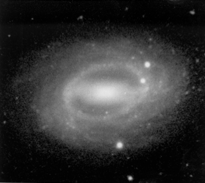
| 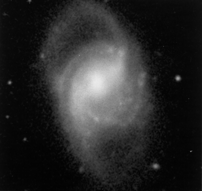
|
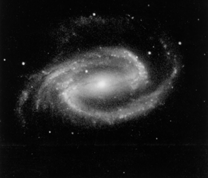
|
Figure 9. Examples
of SAB(r) (IC 1438, top left), SAB(rs) (NGC 619, top right), SAB(s)
(NGC 210, bottom) types.
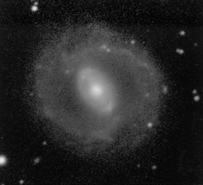
| 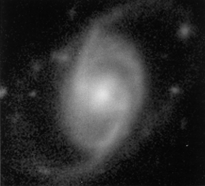
|
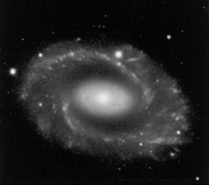
|
Figure 10.
Examples of SA(r) (NGC 6753, top left), SA(rs) (NGC 6935, top right),
SA(s) (ESO 111-10, bottom) types.
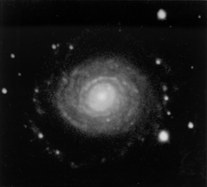
| 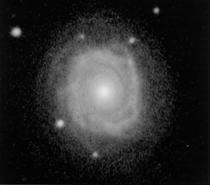
|
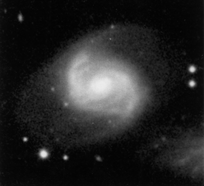
|
The parameter characterizing the third dimension in the classification
volume is the stage T, which varies continuously in the sequence
a, b, c, d, and m, with intermediate types ab, bc, cd, and dm. The
stage expresses the development of spiral structure via the three
principal classification criteria originally outlined by Hubble: the
strength of the bulge, the degree of openness of the spiral structure,
and the degree of resolution of the arms.
Sandage (1961)
noted that the
pure ring form (r) parallels the pure spiral form (s) over the sequence
Sa, SBa to Sc, SBc, but that at later stages the pure ring form is
not common. He noted that most central rings in the Sc subclass
are broken into several segments, characteristic of the (rs),
pseudo-ringed variety. From a re-classification of 1500 bright galaxies
taken mostly from the well-known catalog of
Shapley & Ames (1932),
de Vaucouleurs (1963)
showed that the relative frequency of the
pure ring variety (r) is highest near stage Sab, accounting for nearly
40% of the varieties observed at that stage, and that the phenomenon
considerably weakened or became absent in the later spiral stages.
Two late-type inner-ringed galaxies are shown in
Figure 11.
Figure 11.
Examples of late-type ringed galaxies: NGC 2835 (left) and NGC 3124
(right).
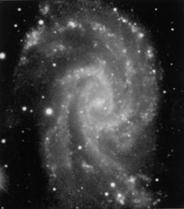
| 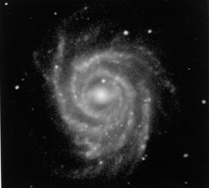
|
Rings were also found in these early studies to be present in
lenticular (S0) galaxies. In Hubble's original
(1926)
classification
system, ringed, barred lenticulars were misclassified as SBa systems
because the S0 category had not been fully recognized at the time.
Sandage (1961;
and more recently
Sandage & Bedke
1994 = SB94)
described
Hubble's final classification of lenticulars. In nonbarred
lenticulars, a central lens is surrounded by a faint envelope. A stage
sequence (S01 -> S02 -> S03) is identified
whereby the envelope and lens develop from a smooth luminosity
distribution in early stages to a profile perturbed by a narrow,
circular absorption ring. The galaxy NGC 4429, shown in
Figure 12,
bottom, has such an absorption ring. The region outside the absorption
ring appears enhanced, giving the impression of an internal ring
similar to those observed in spirals. Sandage did not associate these
rings directly with the (r)-subtype, but de Vaucouleurs did classify
them as inner rings. (The second, larger ring-like feature in NGC 4429
was classified by de Vaucouleurs as an outer ring.) Sandage noted a
gradual transition whereby the absorption ring in the later lenticular
stage begins to deviate from circular patterns and take on a tightly
wound spiral form as the stage sequence progresses. In barred
lenticulars (and many nonbarred ones as well), rings are often found at
the edge of a lens, which also develops along the stage sequence into
spiral arms. In fact, Sandage noted that the structural features of
barred galaxies can be characterized by ``a sequence in which a simple
pattern of bar and ring develops into a pattern of bar and spiral
arms.''
Figure 12.
Examples of ringed S0 galaxies: NGC 4553 (left) and NGC 4429 (right).
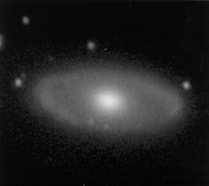
| 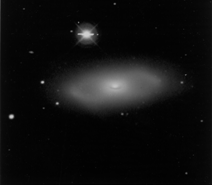
|
The classification of lenticulars in the Hubble Atlas and in
SB94 does
not recognize varieties because S0 galaxies, by definition, do not have
spiral structure. However, de Vaucouleurs adopted a different
interpretation and recognized family and variety for lenticulars in the
same manner as for spirals, i.e., as continuous properties. Ringed,
pseudoringed, and non-ringed varieties at each family are recognized in
an analogous manner to spirals. The principal difference with spirals
is a notable deficiency of the hybrid type, SAB(rs)0, which
de Vaucouleurs (1963)
attributed to difficulty of classification. The
strongest inner rings in lenticulars are characteristic of the ``late''
de Vaucouleurs lenticular type S(r)0+. NGC 4553
(Fig. 12, left) and
NGC 7187
(Buta 1990b,
Fig. 13) are two
excellent examples of late, nonbarred lenticulars. NGC 4429 in
Figure 12 is an
unusual case because its ``outer ring'', which is actually an
intermediate spiral pseudoring zone, bears an uncanny resemblance to
the inner hexagonal zone of NGC 7020 (see
Fig. 1). The
significance of this similarity is not yet clear.
Figure 13. The
double ringed lenticular galaxy NGC 7187, type
(R)SA(r)0+. Note the shape difference between the two rings.
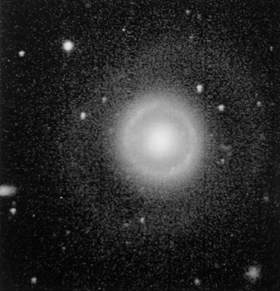
|
1
Lundmark (1926)
published a preliminary classification of
``anagalactic nebulae'' that also recognized ring morphologies. His
spiral category, As, included subclasses where spiral arms ``form a
bright ring'', ``Saturn-shaped'' nebulae, and Curtis  -type spirals. The
system, however, never saw extended use. Back.
-type spirals. The
system, however, never saw extended use. Back.



 -type''
spirals, ``for lack of a better name.'' The objects Curtis first
described are now recognized as ``barred spirals'', a term coined by
Hubble (1926),
and the near perfect ring as an ``inner ring.'' Although
Curtis referred to them as
-type''
spirals, ``for lack of a better name.'' The objects Curtis first
described are now recognized as ``barred spirals'', a term coined by
Hubble (1926),
and the near perfect ring as an ``inner ring.'' Although
Curtis referred to them as  -type, a term such as
-type, a term such as  -type is
actually more appropriate since the bar never exceeds the extent of the
ring (see Figure 3).
(1)
Hubble (1926)
would have used
the term
-type is
actually more appropriate since the bar never exceeds the extent of the
ring (see Figure 3).
(1)
Hubble (1926)
would have used
the term  -type in
his classification system, but Greek letters were inconvenient for
catalogs in his day, so he chose the term ``barred spirals'' instead.
Typically, the spiral structure of such a galaxy emerges from the inner
ring, but
Reynolds (1921)
discovered two examples where only the
-type in
his classification system, but Greek letters were inconvenient for
catalogs in his day, so he chose the term ``barred spirals'' instead.
Typically, the spiral structure of such a galaxy emerges from the inner
ring, but
Reynolds (1921)
discovered two examples where only the
 shape was visible on his
plates. Later, Hubble
(1926,
1936)
observed that the appearance of the
ring in the
shape was visible on his
plates. Later, Hubble
(1926,
1936)
observed that the appearance of the
ring in the  -types was
manifested by a tight spiral structure, which became more open as the
spiral sequence progressed. In the
-types was
manifested by a tight spiral structure, which became more open as the
spiral sequence progressed. In the  -type spiral (NGC 1433) illustrated in
Figure 3, the
ring is a tight spiral pattern that closes around the bar ends.
-type spiral (NGC 1433) illustrated in
Figure 3, the
ring is a tight spiral pattern that closes around the bar ends.






















